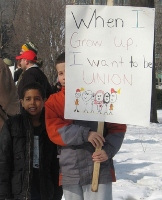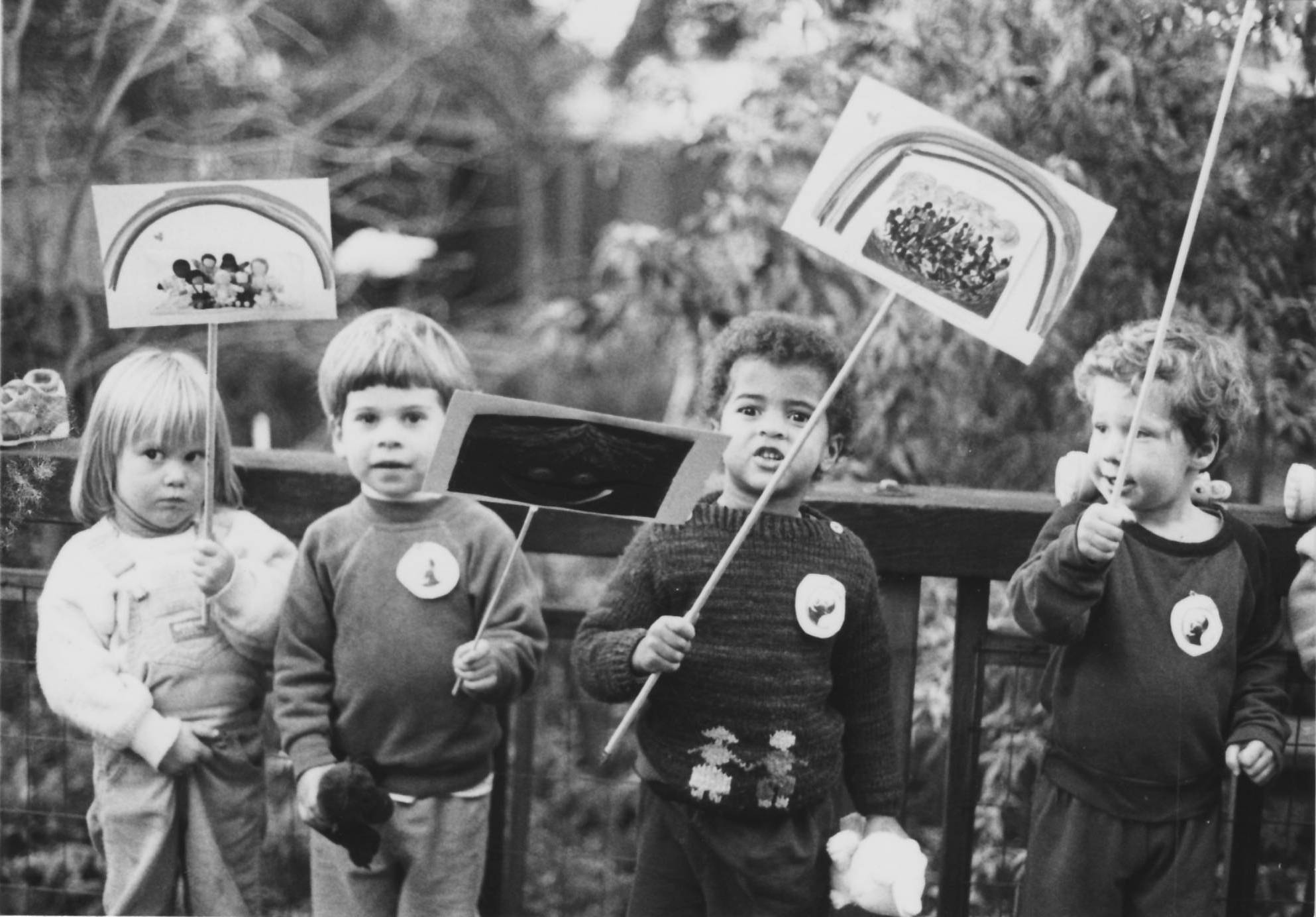Fostering Young Children’s Thinking About Fairness and Cooperative Action
By Louise Derman-Sparks and Julie Olsen Edwards

The political struggle in Wisconsin, Ohio, Indiana, and several other states over the right to unionize has thrust working people into the limelight. The threat to unionized labor, and the economic and health benefits supported by unions, also threatens children’s quality of life—now and in the future. In fact, millions of families and children risk losing their quality of life. Proposed and enacted state budget cuts to public education weaken the capacity of schools to educate the vast majority of children living in working and middle-class American households. In addition, our children are surrounded by contradictory messages about the very people who teach and serve them in their communities.
What young children learn about economic class in this continued debate about economic and job security will affect how they perceive themselves and the world around them. They are taking in a range of messages about these events, from the wide variety of views on television to the opinions and statements of their own families on economic matters. Attitudes supporting unions and those blaming unions for the economic hardships in our country are all swirling around them. Now is an especially good time to educate and engage children about the work people do, labor, and about people working together to improve our lives.
 By preschool age, children absorb messages from both society and family about the value and importance of different kinds of work, including what their families do. They are influenced by the prevailing misinformation about what makes people affluent, or poor. The relative affluence of their families shapes their attitudes toward economic class differences and their own economic status and prospects. They learn about who is important enough to be visible and valued from sources such as children’s books, videos, television, advertising and toys, and from their early childhood curriculum. Many kinds of valuable work seldom get seen (e.g., waitresses, farmworkers, custodians, domestic workers, store clerks, office workers, homemakers, and artists).
By preschool age, children absorb messages from both society and family about the value and importance of different kinds of work, including what their families do. They are influenced by the prevailing misinformation about what makes people affluent, or poor. The relative affluence of their families shapes their attitudes toward economic class differences and their own economic status and prospects. They learn about who is important enough to be visible and valued from sources such as children’s books, videos, television, advertising and toys, and from their early childhood curriculum. Many kinds of valuable work seldom get seen (e.g., waitresses, farmworkers, custodians, domestic workers, store clerks, office workers, homemakers, and artists).
Children’s understanding of economic class changes as they grow up. Young elementary school children are likely to both describe and explain poverty and wealth in observable concrete terms, such as number of possessions and type of residence. From an early age they are aware that their parents work hard—often equating this hard work with not being available to be with them. When they are around 10 years of age, children begin to refer to psychological traits, such as motivation, in their explanations of why people are in different circumstances. During childhood and adolescence, children increasingly make the connection between having a job and getting money; and they are more aware of the status and financial benefits associated with specific occupations. Finally, adolescents are capable of seeing the role of the social and economic structure in the unequal distribution of wealth.
Children also have ideas about economic disparities and fairness. Often preschoolers say that it is not fair that some people have more money than others do and the rich should share with poor people. Elementary school children may also advocate equalizing the wealth between rich and poor. However, older children and adolescents are more likely to justify inequalities by claiming that poor people get what they deserve (“They didn’t work hard enough”). Children and adolescents from working poor families may succumb to the power of that myth and feel confused and disturbed about their families, who work very hard, yet still have little money.

The explosive growth of consumerism in the past three decades aggravates the effects of economic disparities. Advertising abounds that targets children on television, in films, and in print with the message that they should want and need to have the latest film spin-off toy, clothing, sugary cereal, action figure, or doll (for more information, Commercial Free Childhood). Receiving new toys and clothes is increasingly equated (for parents and children) with being “good” and being loved. American children have become a $42 billion market in terms of direct spending by their families on them and a $700 billion market when we factor in how they influence parent spending more broadly (e.g., response to child-directed ads about which clothes and cars to buy or where to vacation). Indeed, the U.S. child-related market is bigger than the total economies of the 115 poorest countries in the world (Media Education, 2009). Children do not yet have the skills to sort out or resist these pervasive messages. Their attitudes are quite often two-dimensional/simplistic: They feel deprived, unloved, or unworthy when they do not have the advertised object or they feel reassured, valued, and superior when they do have the advertised objects.
Here are several concepts and strategies for young children (preschool, kindergarten, 1st grade) about work, fairness, and people helping each other create a better life — the core issues of the current labor struggles. We look forward to hearing about what you do, so please add your comments below.
Concept 1: Families do many kinds of work and all kinds of work are helpful to others.
Make a wall chart about all the kinds of work the children’s families do. Make clear that all work helps people in a variety of ways. Invite family members to tell you about what they do, and if they can, invite them to talk with the children (include aunts, uncles, older siblings, and grandparents as well as parents). Also include the tasks that an unemployed family member has done and what they currently do to help their family.
Honor the people who work in your center or school. Make another chart of the people who work in and for your educational program—the janitors, secretaries, etc.; use photographs; ask them to come in and talk about their families and interests (it’s important children see them as fully rounded people); engage the children in making thank-you cards for each person.
Read books about different kinds of work (blue collar, farming, service, white collar, professional, the arts), and explore how each job helps people: A Day’s Work (best with 5- to 7-year-olds—but good for some 4-year-olds, too) about a young boy and his abuelito looking for work as day laborers; or Mama, I’ll Give You the World about a mom who works in a beauty parlor.
Recommended booklist: Early Childhood: Learning About Economic Class and Fairness
Concept 2: Families do all kinds of work at home
Make a wall chart about all the kinds of work that happens at home. Primary-age children can bring a list home and check off what they see their family members doing.
If your program celebrates or studies holidays, use them to emphasize gifts of the heart rather than purchased gifts. Ask children about what fun activities their family did together rather than what gifts they received. Create an ongoing class book about people being kind to one another, called “The Best Gift of All.” Help children dictate stories for the book throughout the year, and read it frequently at circle times.
Read Mama Bear, the only book we know for little ones that illustrates that even if you work hard and are good you may not get a new toy (but you can still have a snugly, loving mom).
Concept 3: Engaging young children in activities to create positive change
Be alert for unfair practices that directly affect their lives. The children or you may identify the problem.
Engage children in dialogue about their feelings and ideas regarding the specific situation. Provide information as appropriate.
Consider the interests and dynamics of your group of children. Do they care about the problem? What kind of actions would help them appropriately address the issue?
Plan and carry out activities appropriate to the children and their families to address the problem you have chosen. If one action works, great! If it does not, try again with a different activity.
Recommended books:
- Somewhere Today: A Book of Peace (by Shelley Moore Thomas)
- Subway Sparrow (by Leyla Torres), in which a multilingual group of adults and children work together to save a sparrow caught in the subway.
Recommended booklist: Activism with Young Children
Concept 4 (for Teachers): Have the same high expectations for children from every family.
Have the same high expectations for children from every family. Pay attention to children’s varying learning styles and differences in knowledge and skills and adapt activities to support the strengths children bring into your program. Ask for help from others in your program to examine your beliefs and uncover any biases you may have about children’s abilities as they relate to the economic class of their families.
Encourage children to share information about their experiences rather than showing new possessions during circle and sharing times. Do not make a big fuss over “new” toys and materials in the classroom. Be alert, too, and celebrate children and staff ideas for reusing classroom materials, making materials, or finding recycled materials.
Teach children to value their own and each other’s internal qualities (e.g., kindness, generosity, alertness) over external ones (clothes, physical appearance, material possessions).
Help children learn to work together cooperatively. Make class murals out of handprints or drawings. Create a class quilt with each child contributing a square. Ask teams of children to do specific tasks together (e.g., setting the snack tables, clearing up the block area, use toys and materials cooperatively). With primary children, encourage collaborative work on academic tasks.
To learn more about goals and strategies for working with young children on economic class and fairness, see Anti-Bias Education for Young Children and Ourselves (Derman-Sparks & Olsen, NAEYC, 2010).
Also Recommended
- Resources for Teachers
- Rethinking Early Childhood Education